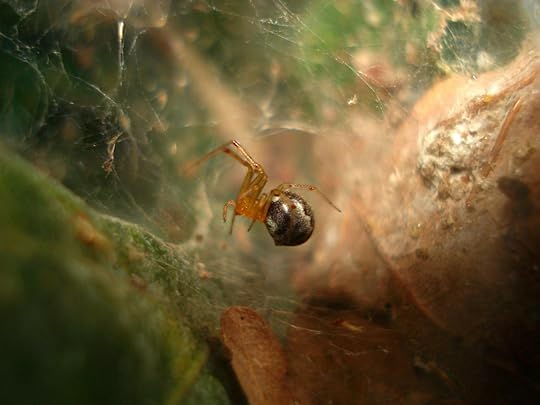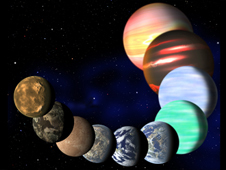Michael J. Behe's Blog, page 440
August 22, 2019
Want more aggressive spiders? Look for hurricanes

ANELOSIMUS STUDIOSUS SPIDER/JOSEPH T LAPP
Okay, it’s a nice summer evening and here’s some fun: Researchers found that hurricanes promote the emergence of aggressive spiders:
As a species, A. studiosus is divided into two sets of inherited personality traits: docile and aggressive. The aggressiveness of a colony is determined by the speed and number of attackers that respond to prey, the tendency to cannibalize males and eggs, the vulnerability to infiltration by predatory foreign spiders, among other characteristics.
Aggressive colonies, for example, are better at acquiring resources when scarce but are also more prone to infighting when deprived of food for long periods of time or when colonies become overheated.
“Tropical cyclones likely impact both of these stressors by altering the numbers of flying prey and increasing sun exposure from a more open canopy layer,” explains Pruitt. “Aggressiveness is passed down through generations in these colonies, from parent to daughter, and is a major factor in their survival and ability to reproduce.”
The analysis suggested that after a tropical cyclone event, colonies with more aggressive foraging responses produced more egg cases and had more spiderlings survive into early winter. The trend was consistent across multiple storms that varied in size, duration and intensity, suggesting the effects are robust evolutionary responses, says Pruitt.
McMaster University, “Researchers find hurricanes drive the evolution of more aggressive spiders” at Eurekalert
Here’s the open-access study.
One researcher sees a prophecy in this:
Lead author Jonathon Pruitt, an evolutionary biologist at McCaster University said: “Tropical cyclones likely impact both of these stressors by altering the numbers of flying prey and increasing sun exposure from a more open canopy layer.
“Aggressiveness is passed down through generations in these colonies, from parent to daughter, and is a major factor in their survival and ability to reproduce.”
He added: “As sea levels rise, the incidence of tropical storms will only increase. Now more than ever we need to contend with what the ecological and evolutionary impacts of these storms will be for non-human animals.”
Phoebe Weston, “Hurricanes help aggressive spiders spread, study finds” at The Independent
You will be glad to learn, via USA Today: “The spiders are not aggressive towards humans, rather in their own environments for survival purposes.”
Maybe we could get the aggressive spiders to attack household ants, flies, and cockroaches then?
Seriously, the main question is, when the weather calms down, won’t the spiders tend to just stop being so aggressive? It’s interesting if this is what is meant by “robust evolutionary responses.”
See also: Researchers puzzle over a dolphin who adopted ababy melon-headed whale
Follow UD News at Twitter!
Copyright © 2019 Uncommon Descent . This Feed is for personal non-commercial use only. If you are not reading this material in your news aggregator, the site you are looking at is guilty of copyright infringement UNLESS EXPLICIT PERMISSION OTHERWISE HAS BEEN GIVEN. Please contact legal@uncommondescent.com so we can take legal action immediately.
Plugin by Taragana
Straw in the wind? Darwin’s random variation is discredited in a recent paper
From the University of Glasgow. A friend draws our attention to these words in a recent open-access paper: “Although biologists are now moving beyond the idea that random mutation provides the sole source of variation for adaptive evolution, we still assume that variation occurs randomly…” in the Abstract.
Later: “Darwin’s idea that variation is generated randomly has largely been taken for granted rather than tested, representing a fundamental gap in our understanding of evolution.”
They propose “nonrandom variation”:
Abstract: The generation of variation is paramount for the action of natural selection. Although biologists are now moving beyond the idea that random mutation provides the sole source of variation for adaptive evolution, we still assume that variation occurs randomly. In this review, we discuss an alternative view for how phenotypic plasticity, which has become well accepted as a source of phenotypic variation within evolutionary biology, can generate nonrandom variation. Although phenotypic plasticity is often defined as a property of a genotype, we argue that it needs to be considered more explicitly as a property of developmental systems involving more than the genotype. We provide examples of where plasticity could be initiating developmental bias, either through direct active responses to similar stimuli across populations or as the result of programmed variation within developmental systems. Such biased variation can echo past adaptations that reflect the evolutionary history of a lineage but can also serve to initiate evolution when environments change. Such adaptive programs can remain latent for millions of years and allow development to harbor an array of complex adaptations that can initiate new bouts of evolution. Specifically, we address how ideas such as the flexible stem hypothesis and cryptic genetic variation overlap, how modularity among traits can direct the outcomes of plasticity, and how the structure of developmental signaling pathways is limited to a few outcomes. We highlight key questions throughout and conclude by providing suggestions for future research that can address how plasticity initiates and harbors developmental bias. pdf.(open access) – Does phenotypic plasticity initiate developmental bias? Kevin J. Parsons Kirsty McWhinnie Natalie Pilakouta Lynsey Walker Evolution & Development First published: 26 July 2019 https://doi.org/10.1111/ede.12304 More.
Perhaps the researchers will help elucidate some laws that govern development over time.
Darwin, our friend notes, felt much more strongly about the importance of randomness, as he told Lyell: “If I were convinced that I required such additions to the theory of natural selection, I would reject it as rubbish.” (To Charles Lyell 11 October [1859])
See also: So creationism works—but only for genes? So 2/3 of the time, we have “ de novo emergence from ancestral non-genic sequences, such that homologues genuinely do not exist?” Okay. Somebody better go put their arm around the Selfish Gene. It’s tough being the Last Darwinian.
Gene, we did not do this to you. Francis Collins and Craig Venter did this to you. Honest.
and
Direct experimental falsification of Darwinism? (The Selfish Gene was heard to sob uncontrollably in the background.)
Follow UD News at Twitter!
Copyright © 2019 Uncommon Descent . This Feed is for personal non-commercial use only. If you are not reading this material in your news aggregator, the site you are looking at is guilty of copyright infringement UNLESS EXPLICIT PERMISSION OTHERWISE HAS BEEN GIVEN. Please contact legal@uncommondescent.com so we can take legal action immediately.
Plugin by Taragana
And so now psychoanalyst Carl Jung was a racist too…
 Carl Jung
Carl Jung Darwinians have gone to such lengths to defend Darwin when, it is becoming clear, everybody who lived before Political Correctness was a racist. One interesting thing about the linked story about Jung (1875-1961) is the pushback it is getting from the combox.
But not to get ahead of ourselves,
Today, Jungian or analytical psychology retains an active community. But a recently published Open Letter from a number of prominent Jungians points to troubles within the fold.
The letter acknowledges that Jung’s writings contained racism, and apologizes for the failure of Jungians to confront this fact earlier.
The Open Letter refers in particular to a 1988 paper by Farhad Dalal, which was bluntly titled Jung: A Racist. In this piece, Dalal pointed to several instances of racism in Jung’s writings, aimed mostly at Africans, but also Indians and Arabs.
Neuroskeptic, “The Racism of Carl Jung” at Discover Magazine
Well, if Jung was a racist, then Darwin was a racist too. Too bad those things can’t just be admitted so we can move on. We can’t deal with the consequences of things we can’t admit.
And the biggest consequence, which Neuroskeptic helpfully identifies, is “the question of whether Jung’s racism was an integral part of his psychological theory.” Indeed. With Darwin, the idea of inferior human races seems to have been fundamental. Someone had to be the subhuman or his theory didn’t make sense.
See also: Was Neanderthal man fully human? The role racism played in assessing the evidence
In any Darwinian scheme, someone must be the subhuman. Otherwise, there is no beginning to human history.
and
Do racial assumptions prevent recognizing Homo erectus as fully human?
Follow UD News at Twitter!
Copyright © 2019 Uncommon Descent . This Feed is for personal non-commercial use only. If you are not reading this material in your news aggregator, the site you are looking at is guilty of copyright infringement UNLESS EXPLICIT PERMISSION OTHERWISE HAS BEEN GIVEN. Please contact legal@uncommondescent.com so we can take legal action immediately.
Plugin by Taragana
At First Things, they are also getting over Darwinism
 George Weigel
George WeigelResponding to David Gelernter at Claremont Review of Books, George Weigel writes,
Gelernter is intrigued by “intelligent design” approaches to these evolutionary conundra but also suggests that, “as a theory,” intelligent design “would seem to have a long way to go.” But to dismiss intelligent design out of hand—to brand it piety masquerading as science—is, well, unscientific. The fossil record and molecular biology now suggest that Darwinian answers to the Big Questions constitute the real fundamentalism: a materialistic fideism that, however shaky in dealing with the facts, is nonetheless deeply entrenched in 21st-century imaginations. Thus, Gelernter asks whether today’s scientists will display Darwin’s own courage in risking cultural disdain by upsetting intellectual apple carts.
George Weigel, “Getting Beyond Darwin” at First Things
First, the Hoover Institution. Then Powerline. Now First Things.
Here’s what’s different: In the past, all these think tanks seemed to bow to the idea that Darwinism was in some sense right even though it grossly mishandled the human story.
Maybe Darwinism got the world as a whole right. (Cosmic Darwinism?)
Or maybe it got the termites right, for example. But then, come to think of it, termite expert J. Scott Turner doesn’t think they got the termites right, to judge from his 2017 Purpose and Desire: What Makes Something “Alive” and Why Modern Darwinism Has Failed to Explain It.
Over the years, many of us found these many of these think tanks’ behavior frustrating—especially, their unwillingness to engage with the evidence, as opposed to conceding Darwinian talking points. But they seem to be getting past that phase now.
At some point, the question should become: Apart from their unquestioned capacity to generate pop science drivel and wreck the careers of serious science doubters, what exactly did the Darwinists get right that no one else did?
What, exactly, is the Darwinists’ unique contribution?
—
Further reading along these lines: Another Think Tank Now Openly Questions Darwinism So Power Line is interviewing J. Scott Turner, author of Purpose and Desire: What Makes Something “Alive” and Why Modern Darwinism Has Failed to Explain It. He’s not an “ID guy” but that doesn’t matter. His book’s title tells you what you need to know. He understands that something is wrong. And his insights into insects’ hive mind are a piece in the puzzle.
Hoover Institution interview with David Berlinski
Mathematicians challenge Darwinian Evolution
The College Fix LISTENS TO David Gelernter on Darwin! It’s almost as though people are “getting it” that Darwinism now functions as an intolerant secular religion. Evolution rolls on oblivious but here and there heads are getting cracked, so to speak, over the differences between what really happens and what Darwinians insist must happen.
Follow UD News at Twitter!
Copyright © 2019 Uncommon Descent . This Feed is for personal non-commercial use only. If you are not reading this material in your news aggregator, the site you are looking at is guilty of copyright infringement UNLESS EXPLICIT PERMISSION OTHERWISE HAS BEEN GIVEN. Please contact legal@uncommondescent.com so we can take legal action immediately.
Plugin by Taragana
August 21, 2019
Huh? Stone Age tools developed locally 325 kya?
From ScienceDaily:
The analysis of artifacts from a 325,000-year-old site in Armenia shows that human technological innovation occurred intermittently throughout the Old World, rather than spreading from a single point of origin, as previously thought.
The study, published today in the journal Science, examines thousands of stone artifacts retrieved from Nor Geghi 1, a unique site preserved between two lava flows dated to 200,000-400,000 years ago. Layers of floodplain sediments and an ancient soil found between these lava flows contain the archaeological material. The dating of volcanic ash found within the sediments and detailed study of the sediments themselves allowed researchers to correlate the stone tools with a period between 325,000 and 335,000 years ago when Earth’s climate was similar to today’s…
The stone tools provide early evidence for the simultaneous use of two distinct technologies: biface technology, commonly associated with hand axe production during the Lower Paleolithic, and Levallois technology, a stone tool production method typically attributed to the Middle Stone Age in Africa and the Middle Paleolithic in Eurasia. Traditionally, Archaeologists use the development of Levallois technology and the disappearance of biface technology to mark the transition from the Lower to the Middle Paleolithic roughly 300,000 years ago.
Archaeologists have argued that Levallois technology was invented in Africa and spread to Eurasia with expanding human populations, replacing local biface technologies in the process. This theory draws a link between populations and technologies and thus equates technological change with demographic change. The co-existence of the two technologies at Nor Geghi 1 provides the first clear evidence that local populations developed Levallois technology out of existing biface technology.
“The combination of these different technologies in one place suggests to us that, about 325,000 years ago, people at the site were innovative,” says Daniel Adler, associate professor of Anthropology at the University of Connecticut, and the study’s lead author. Moreover, the chemical analysis of several hundred obsidian artifacts shows that humans at the site utilized obsidian outcrops from as far away as 120 kilometers (approximately 75 miles), suggesting they must also have been capable of exploiting large, environmentally diverse territories.
Paper. paywall – D. S. Adler, K. N. Wilkinson, S. Blockley, D. F. Mark, R. Pinhasi, B. A. Schmidt-Magee, S. Nahapetyan, C. Mallol, F. Berna, P. J. Glauberman, Y. Raczynski-Henk, N. Wales, E. Frahm, O. Jöris, A. MacLeod, V. C. Smith, V. L. Cullen, and B. Gasparian. Early Levallois technology and the Lower to Middle Paleolithic transition in the Southern Caucasus. Science, 2014; 345 (6204): 1609-1613 DOI: 10.1126/science.1256484 More.
The take-home point is that lots of people were innovative back then.
See also: What Neanderthal jewelry means It’s not just that the ornaments did not have a practical use. They probably expressed something. Eagle talons, for example, might imply something about the person who wore them, in the same way that a peace sign implies something about the wearer today. But it may have implied the opposite thing.
Follow UD News at Twitter!
Copyright © 2019 Uncommon Descent . This Feed is for personal non-commercial use only. If you are not reading this material in your news aggregator, the site you are looking at is guilty of copyright infringement UNLESS EXPLICIT PERMISSION OTHERWISE HAS BEEN GIVEN. Please contact legal@uncommondescent.com so we can take legal action immediately.
Plugin by Taragana
“Skeptical Inquirer” calls National Geographic book a “natural disaster”

We don’t hear this often. But this episode is helpful for understanding the real war on science:
Anyone promoting dietary supplements should inform patients that buying them is risky. Numerous independent studies have analyzed the products on the market. They have consistently found errors. Sometimes they contain a different ingredient from what the label promises. The dosage listed on the label is often wrong, with some products containing much less or even no active ingredient and others containing many times what the label says. Contaminants have been frequently found, including heavy metals, carcinogens, insect parts, and even prescription drugs. You can’t be sure what you’re getting. Buying them is a gamble akin to buying street drugs in a back alley.
Many experts have pointed out that there’s no such thing as alternative medicine; there’s only medicine that has been tested and proven to work and medicine that hasn’t. When a medicine has been tested and proven to work, you can’t call it “alternative” anymore; you have to just call it “medicine.”
Harriet Hall, “National Geographic Book Is A ‘Natural’ Disaster” at Skeptical Inquirer
The main thing to see here is that the book is published by National Geographic, once a source you would not have expected to be backing this stuff.
The real war on science is not doubts about Darwin. To the extent that so many people have allowed Darwinists to snooker them into believing that, they likely don’t know what to do now that seriously fact-challenged points of view can parade as virtue.
See also: The progressive war on science takes dead aim at math
and
Which side will atheists choose in the war on science? They need to re-evaluate their alliance with progressivism, which is doing science no favours.
Also: Journalist Wonders, Why Creation Museum Inspires Rage, Whole Foods Scams Don’t (Sky Fell Last Night Too, By The Way)
Follow UD News at Twitter!
Copyright © 2019 Uncommon Descent . This Feed is for personal non-commercial use only. If you are not reading this material in your news aggregator, the site you are looking at is guilty of copyright infringement UNLESS EXPLICIT PERMISSION OTHERWISE HAS BEEN GIVEN. Please contact legal@uncommondescent.com so we can take legal action immediately.
Plugin by Taragana
Jonathan Bartlett replies to Jeffrey Shallit’s “pedantry”

Bartlett, a calculus instructor among other things and author of Calculus from the Ground Up, finds Shallit’s complaints to be out of touch:
Unfortunately, some professors, like the one who attacked my recent article, seem to prefer pedantry…
His post displays most of the reasons why ordinary humans have stopped respecting academics and credentialed experts. That is sad because society needs experts and credentialing serves an important function. Unfortunately, what makes you an expert today is not your clarity of thought but rather your ability to conform your thoughts entirely to the constraints of your profession’s vocabulary…
History shows that Newton’s own development of the idea of infinite series was exactly as I described. In Newton’s day, polynomials were known to be imperfect stand-ins for transcendental functions.
Jonathan Bartlett, “Mathematics gives us life skills and mental tools” at Mind Matters News
See also: Darwinist Jeffrey Shallit asks, why can’t creationists do math? Referring to calculus textbook author Jonathan Bartlett, he writes, “What surprises me is that even creationists with math or related degrees often have problems with basic mathematics.” Bartlett will answer shortly.
Do you think calculus texts are as bad as Jonathan Bartlett does? “They are the most dry and boring presentations of mathematics I have ever seen, especially if you realize that calculus offers some of the most amazing insights.”
and
Walter Bradley Center Fellow discovers longstanding flaw in an aspect of elementary calculus. The flaw doesn’t lead directly to wrong answers but it does create confusion.
Copyright © 2019 Uncommon Descent . This Feed is for personal non-commercial use only. If you are not reading this material in your news aggregator, the site you are looking at is guilty of copyright infringement UNLESS EXPLICIT PERMISSION OTHERWISE HAS BEEN GIVEN. Please contact legal@uncommondescent.com so we can take legal action immediately.
Plugin by Taragana
August 20, 2019
Jeffrey Shallit also holds forth on Yale’s David Gelernter

David Gelernter, by Doc Searls (Flickr: 2010_08_05_techonomy_154) [CC BY 2.0], via Wikimedia Commons
Earlier today, we noted that Jeffrey Shallit had attacked Jonathan Bartlett, author of Jonathan Bartlett is the author of Calculus from the Ground Up, asking why creationists can’t do math:
A commenter noted that he had not seemed to mention computer science prof David Gelernter’s defection from Darwinism. But that “defect” has recently been remedied:
One of the most popular crank topics is evolution, and that’s the subject of today’s blog. Yes, it’s David Gelernter again. Prof. Gelernter, who teaches computer science at Yale, recently wrote a review for the far-right Claremont Review of Books entitled “Giving up Darwin”. All the warning signs are there:
– Gelernter is not a biologist and (to the best of my knowledge) has no advanced formal training in biology. That’s typical: the crank rarely gets cranky in subjects of his own competence. (I say “his” because cranks are almost always male.)
– Gelernter has basically done almost nothing in his own field for the last 20 years (according to DBLP, he’s published only two papers in CS since 1998). That’s also typical:
– intellectually-fulfilled academics are usually happy to contribute more to their own fields of competence, and don’t have the time for bizarre detours into other fields.
– Gelernter is also a devout theist, and has written books praising the wisdom of his particular religious sect. Nearly all the intellectual opposition to evolution comes from theists, who “find in the theory of evolution a disturbing and mysterious challenge to their values” (to quote Anthony West).
– Gelernter pals around with other anti-evolution cranks, like Stephen Meyer and David Berlinski. …
Jeffrey Shallit, “David Gelernter Makes a Fool of Himself Again” at Recursivity
And much more.
Re “Gelernter is not a biologist and (to the best of my knowledge) has no advanced formal training in biology,” we did not realize that math prof Jeffrey Shallit, who defends Darwinism, had biology credentials himself. Well, he must, mustn’t he? But none are listed in the post. But then, if you defend Darwinism, perhaps no credentials are needed.
See also: Darwinist Jeffrey Shallit asks, why can’t creationists do math? Referring to calculus textbook author Jonathan Bartlett, he writes, “What surprises me is that even creationists with math or related degrees often have problems with basic mathematics.” Bartlett will answer shortly.
David Gelernter warns against Darwin mob. You take your life in your hands”? Okay, then they leave us with few options but getting tougher with nonsense. We’ll take the Darwinbird of pop science hostage!
The College Fix LISTENS TO David Gelernter on Darwin! It’s almost as though people are “getting it” that Darwinism now functions as an intolerant secular religion. Evolution rolls on oblivious but here and there heads are getting cracked, so to speak, over the differences between what really happens and what Darwinians insist must happen.
Follow UD News at Twitter!
Copyright © 2019 Uncommon Descent . This Feed is for personal non-commercial use only. If you are not reading this material in your news aggregator, the site you are looking at is guilty of copyright infringement UNLESS EXPLICIT PERMISSION OTHERWISE HAS BEEN GIVEN. Please contact legal@uncommondescent.com so we can take legal action immediately.
Plugin by Taragana
Ocean Methane Production is Ubiquitous
From a PNAS article:
The conditions of methane (CH4) formation in olivine-hosted secondary fluid inclusions and their prevalence in peridotite and gabbroic rocks from a wide range of geological settings were assessed using confocal Raman spectroscopy, optical and scanning electron microscopy, electron microprobe analysis, and thermodynamic modeling. Detailed examination of 160 samples from ultraslow- to fast-spreading midocean ridges, subduction zones, and ophiolites revealed that hydrogen (H2) and CH4 formation linked to serpentinization within olivine-hosted secondary fluid inclusions is a widespread process.
And this from a paper in Nature:
Methane (CH4) is an important greenhouse gas because it has 25 times the global warming potential of carbon dioxide (CO2) by mass over a century. Recent calculations suggest that atmospheric CH4 emissions have been responsible for approximately 20% of Earth’s warming since pre-industrial times. Understanding how CH4 emissions from ecosystems will respond to expected increases in global temperature is therefore fundamental to predicting whether the carbon cycle will mitigate or accelerate climate change.
So, “abiotic” methane production is “ubiquitous,” and methane is 25 times the greenhouse gas that CO2 is, and none of this has even begun to be entered into climate models.
Certainly some of this methane ends up in our oceans as a condensed gas; but, how much more, over this equilibrium position, does this methane get itself up to the surface and into our atmosphere?
From the accompanying Phys.Org Press Release:
Of 160 rock samples analyzed from across the world’s oceans, almost all contained pockets of methane. These oceanic deposits make up a reservoir exceeding the amount of methane in Earth’s atmosphere before industrialization, estimates Frieder Klein, a marine geologist at WHOI and lead author of the study.
“We were totally surprised to find this massive pool of abiotic methane in the oceanic crust and mantle,” Klein said.
For the first two decades in the atmosphere, methane is 84 times greater a greenhouse gas than CO2. And, guess what, they found this methance coming out of the mid-Atlantic Ridge. IOW, they can’t begin to know the extent that these methane emissions affect climate.
Anyone ready to spend 50 trillion dollars to effect changes that won’t change temperatures one twit?
But, you can become a trillionaire if you’re at the receiving end of all of this. Isn’t that good news? NOT!
Copyright © 2019 Uncommon Descent . This Feed is for personal non-commercial use only. If you are not reading this material in your news aggregator, the site you are looking at is guilty of copyright infringement UNLESS EXPLICIT PERMISSION OTHERWISE HAS BEEN GIVEN. Please contact legal@uncommondescent.com so we can take legal action immediately.
Plugin by Taragana
Rob Sheldon: Don’t give up all ET hope due to recent exoplanet disappointment
 types of planets Kepler found/NAA
types of planets Kepler found/NAAEven in our own solar system, he says, there are reasons for believing that the picture is more complicated. Yesterday, we mentioned a recent finding that rocky alien planets orbiting red dwarfs (the favored sites for exoplanet life) might in fact feature too extreme temperatures, based on recent research on one of them (–273 degrees Celsius on the night side and 767 degrees C on the day side, which implies little or no atmosphere to moderate it.).
Anyway, our physics color commentator offers some thoughts:
This report is about the Holy Grail of exoplanets–finding a planet with liquid water on it. So far, the thinking goes, a planet has to orbit its host star at just the right distance so that the temperature is between the freezing and boiling point of water. This “Goldilocks Zone” is further away for big hot stars, and close in for small cool stars. Most stars in our galaxy are smaller/cooler than our Sun, so there are better chances of finding a planet in the GZ for these “red dwarf” stars. Indeed, this is exactly what the planet finder mission is discovering.
![The Long Ascent: Genesis 1â 11 in Science & Myth, Volume 1 by [Sheldon, Robert]](https://i.gr-assets.com/images/S/compressed.photo.goodreads.com/hostedimages/1541285109i/26543752.jpg)
But the kicker is that when a planet is very close to its host star, the tidal forces are also much greater. It is tidal forces that lock our Moon’s rotation so that only one side ever faces the Earth. The same thing happens to planets orbiting a red dwarf–only one side ever faces the star, and that side gets hot, too hot for water, whereas the dark side gets too cold for liquid water.
Some optimists had theorized that if such a planet had a thick atmosphere with strong winds, then the heat could be distributed to the cold/dark side, and perhaps liquid water could still exist. So this paper takes a hard look at one such planet as it orbits its star, and tries to measure the temperature. As far as they can tell, the planet’s dark side is the temperature of space (4K), while the hot side is 1000K (or 750C). It doesn’t look promising for water.
What I find odd, is that in our own solar system, Saturn is far outside the “Goldilocks Zone” yet it has a moon, Enceladus, that is emitting steam jets filled with hydrocarbons. So this fixation on GZ seems overrated. Or to say it differently, life can live in far more extreme environments than the astrobiology community want to consider. It is almost as if this fixation with the GZ is intended to turn a qualitative observation into a quantitative field worthy of funding. The danger of being overly-quantitative is not just the overreliance on models, or the higher risk of failure, but rather the real probability that “certainty” blinds one from observing the actual phenomenon.
It’s not what you don’t know that hurts you, it’s what you do know that ain’t so.
—
Rob Sheldon is the author of Genesis: The Long Ascent
See also: Bad news about life on rocky alien planets.
Kreidberg’s team estimated that the promising planet had temperatures of –273 degrees Celsius on the night side and 767 degrees C on the day side, which implies little or no atmosphere to moderate it.
Copyright © 2019 Uncommon Descent . This Feed is for personal non-commercial use only. If you are not reading this material in your news aggregator, the site you are looking at is guilty of copyright infringement UNLESS EXPLICIT PERMISSION OTHERWISE HAS BEEN GIVEN. Please contact legal@uncommondescent.com so we can take legal action immediately.
Plugin by Taragana
Michael J. Behe's Blog
- Michael J. Behe's profile
- 219 followers



